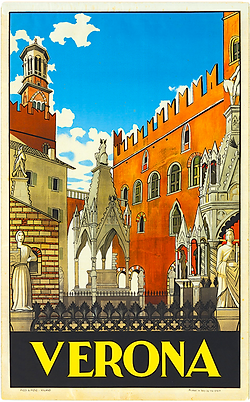top of page


Valpolicella DOC
Organic
Valpolicella
The valley of many cellars
The viticulture tradition in the area is very long and was already established before Roman times. There is archaeological evidence that a group of people called the Arusnates, living in the region around the 5th century BC, were devoted to vine growing. At that time the area was a Roman territory called Pagus Arusnatium, which probably gave the name to its inhabitants.
valpolicella

Valpolicella
The valley of many cellars

Museo Nazionale Collezione Salce
TITOLO
Verona
SOGGETTO
Verona, arche Scaligere di Cansignorio e Mastino II della Scala, con la facciata laterale del palazzo del Podestà e la torre dei Lamberti sullo sfondo
DATA
1919 post - 1941 ante
Valpolicella is a hilly area at the foot of the Venetian Prealps comprised of several small valleys east of Lake Garda. The name appears for the first time in 1177 in an imperial decree by Frederick I of Swabia (aka Barbarossa) with the name “Val Polesela”, but its etymology is still very debated. A theory affirms it is derived from the Greek-Latin “vallis polis cellae” meaning “valley of many cellars”; according to another, currently more popular, it comes from the Latin “vallis pulicellae”, where the word “pulicellae” would be a derivation of the root “pol”, which indicates those rich in vegetation, woody areas developing on fluvial deposits.
The viticulture tradition in the area is very long and was already established before Roman times. There is archaeological evidence that a group of people called the Arusnates, living in the region around the 5th century BC, were devoted to vine growing. At that time the area was a Roman territory called Pagus Arusnatium, which probably gave the name to its
inhabitants. Very little is known about the origin of these people, the most accredited theories identify them as Etruscans, Celts or Raeti.
At that time a prestigious wine was produced in this region, the “Rhaeticum”, which has been celebrated by many historians of the past such as Pliny and Virgil. Pliny in particular compared it to the highly praised Falernian wine (the Mouton of the antiquity) produced in Campania. Roman physician Celsus even recommended it for medical purposes.
A historical character that had a significant influence in winemaking in Valpolicella is Zeno, bishop of Verona, martyr and saint (4th century AD), who taught the producers of the time about the importance of a long barrel ageing for the wine “ut melius veterascendo reddatur” (so that it can improve with maturation).


VALPOLICELLA DOC
Denominazione di Origine Controllata
Organic
Ruby red colour. Aromas of cherry, rose and almond. Good structure with pleasant tannins and refreshing acidity, which makes it a versatile wine to pair with food
By the 5th century the wine produced in the region was already very appreciated and in high demand, as attested in some letters by Cassiodorus, officer at the court of king Theodoric the Great.
Valpolicella’s flourishing wine production also shaped its architectural landscape: the region hosts many prestigious villas from the 15th-16th century, which are not only relevant for their artistic value, but also historically important as they have been a meeting point for many intellectuals of the time.
Today’s Valpolicella wine is a blend of different autochthonous varieties, the main one being Corvina Veronese, which must account for a minimum of 45% up to 95% of the blend. The other important grape required by DOC law is Rondinella, allowed at a percentage between 5 and 30%. Other minor local varieties, such as Molinara and Oseleta, might be included too depending on the producer’s style.

Corvina is the region’s most distinguished grape; thanks to its phenolic characteristics it gives the blend structure, acidity backbone as well as that sour cherry fruit and rose character which is typical of Valpolicella. The name Corvina might not derive from the word “crow” in reference to the dark colour of the berries as previously thought, but more likely from the dialect word “cruina” (which is actually another official name of this variety), meaning “unripe”, in reference to its late ripening characteristic.
There is one grape that by DOC law can replace Corvina up to a 50% and that’s Corvinone. This variety has long been considered a clonal mutation of Corvina, but ampelographic and DNA profiling actually showed they are two different grapes although they are probably genetically related. Its name can probably be attributed to the fact that it resembles Corvina but the size of its berries is much larger, which makes it an ideal substitute for the prestigious passito style wines produced in the area such as the lusciously sweet Recioto and the drier, high-alcohol and complex style of Amarone.
bottom of page
